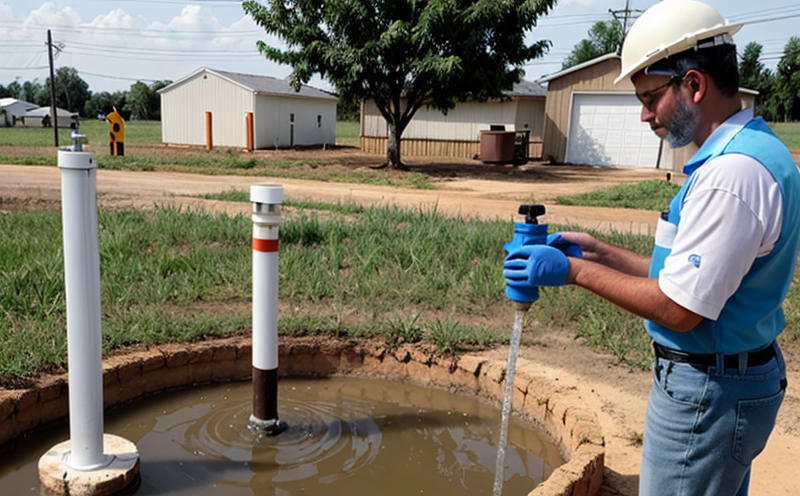ISO 5667-22 On-site Groundwater Parameter Testing
The ISO 5667-22 standard provides a comprehensive framework for on-site parameter testing of groundwater. This method is critical in environmental monitoring, quality assurance, and compliance with regulatory standards. The primary objectives include the accurate measurement of key parameters to ensure that groundwater quality meets both local and international requirements.
The procedure involves the use of portable instrumentation designed specifically for fieldwork. It ensures that the sampling process does not alter the natural state of the water body, thus providing reliable and representative data. Groundwater is often a critical resource in many sectors including agriculture, urban development, and public health. Accurate parameter testing helps prevent contamination, supports sustainable practices, and enhances decision-making processes.
The parameters measured under ISO 5667-22 include but are not limited to pH levels, conductivity, temperature, dissolved oxygen (DO), specific conductance, turbidity, nitrate, phosphate, iron, manganese, total coliforms, E. coli, and many others. Each parameter has specific measurement techniques and units of reporting as defined by the standard.
Sampling methods are tailored to ensure that samples represent the true state of the groundwater without any bias introduced during collection. This includes proper handling of equipment and personnel to avoid contamination from external sources. The method also specifies the types of containers used, storage conditions, and time limits for analysis based on parameter sensitivity.
The acceptance criteria outlined in ISO 5667-22 ensure that only data meeting these standards is considered valid. This includes not just the accuracy and precision of measurements but also the integrity of the sampling process itself. Compliance with these criteria ensures high-quality, reliable testing results that are essential for effective management and monitoring.
The use of on-site parameter testing under ISO 5667-22 helps in identifying potential sources of contamination early. This proactive approach is crucial for preventing larger-scale issues that could impact public health or the environment. It also supports sustainable practices by ensuring that groundwater resources are used responsibly and sustainably.
In summary, ISO 5667-22 on-site parameter testing is a vital tool in the arsenal of environmental professionals working to protect and manage our most precious natural resource—groundwater. Its application spans various sectors including agriculture, urban development, public health, and industrial processes where groundwater plays a crucial role.
Why It Matters
The importance of accurate groundwater parameter testing cannot be overstated in today's world. Groundwater is not only a vital resource for drinking water but also supports ecosystems and agriculture worldwide. Ensuring that this critical resource meets quality standards helps protect public health, supports sustainable development goals, and maintains ecological balance.
- Health Protection: Contaminated groundwater can lead to serious health issues if consumed by humans or livestock. Regular testing ensures that water is safe for consumption.
- Ecosystem Preservation: Groundwater sustains many ecosystems, from wetlands to forests. Ensuring its quality helps preserve biodiversity and supports ecosystem services.
- Sustainable Use: By monitoring groundwater parameters, we can ensure sustainable use practices that prevent over-extraction and degradation of these resources.
The ISO 5667-22 standard ensures that testing is conducted with the highest level of accuracy and reliability. This not only builds trust among stakeholders but also facilitates better decision-making processes in managing groundwater resources.
Environmental and Sustainability Contributions
- Reduction in Contamination: By identifying contaminants early, ISO 5667-22 helps prevent further spread of contamination into the groundwater system.
- Sustainable Resource Management: Accurate parameter testing ensures that groundwater resources are used sustainably, minimizing long-term environmental impacts.
- Biodiversity Preservation: Ensuring water quality supports ecosystems and biodiversity, promoting a healthy environment for all life forms.
The standard plays a crucial role in supporting international sustainability goals by providing reliable data that informs policy decisions. It helps in the development of effective strategies to manage groundwater resources sustainably while ensuring compliance with environmental regulations.
Use Cases and Application Examples
- Agricultural Water Quality Monitoring: ISO 5667-22 is widely used in agricultural settings to monitor water quality parameters that affect crop health and yield. This helps farmers make informed decisions about irrigation practices.
- Urban Development Projects: During urban development, groundwater testing ensures that construction activities do not adversely impact the local water supply. It supports sustainable urban planning by minimizing environmental impacts.
- Potable Water Supply: In areas where potable water supplies depend on groundwater, ISO 5667-22 helps ensure that these supplies meet health and safety standards.
- Industrial Processes: For industries reliant on groundwater for processes like cooling or chemical synthesis, accurate testing ensures compliance with industrial hygiene standards.
The versatility of this standard allows it to be applied across various scenarios where reliable groundwater parameter data is essential. Its widespread use underscores its importance in environmental management and sustainability efforts globally.





